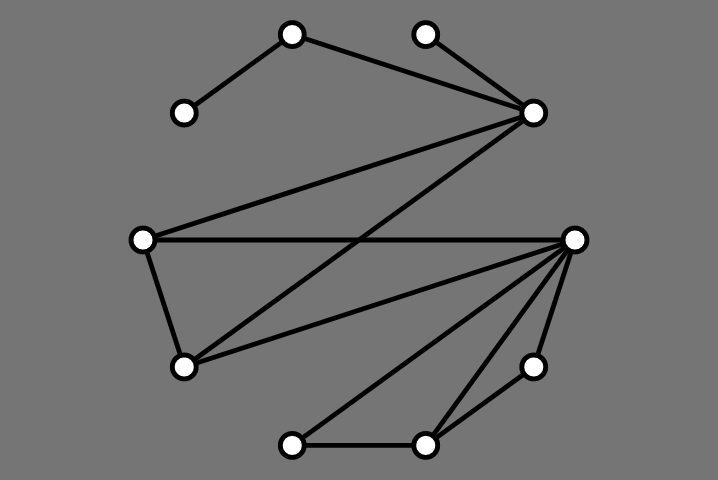Lecture 16: Drawing General Graphs II
COSC 225: Algorithms and Visualization
Spring, 2023
Announcements
- Assignment 07 posted, due Friday
- Quiz Next Monday
- Apply Tidy Tree algorithm by hand
- Assignment 08 posted soon, due next Friday
- Limited OH This Week (advising week)
- No OH today
- No OH on Thursday
Outline
- AVSDF Circular Layouts
- Force-directed Graph Layout
Goals
From Fruchterman and Reingold (1991):
- Distribute the vertices evenly in the frame.
- Minimize edge crossings.
- Make edge lengths uniform.
- Reflect inherent symmetry.
- Conform to the frame.
Last Time: Circular Layouts

Simpler Challenge: pick an order for vertices
Mäkinen Procedure
- Find two vertices of highest degree and add them to
left/right sets
- Repeat until all vertices are added to
left or right:
- compute (
right neighbors) - (left neighbors) for each vertex
- add vertex with largest value to
right
- add vertex with smallest value to
left
- Add
left vertices on left side, right on right side
Mäkinen Results: Before

Mäkinen Results: After

AVSDF Heuristic
Adjacent Vertex Smallest Degree First
Idea:
- perform depth-first search, starting from vertex of minimal degree
- always explore minimum degree neighbor first
AVSDF Example
1: 2, 6, 3, 5
2: 1, 3, 5, 6
3: 1, 2, 6
4: 2, 5
5: 1, 2, 4
6: 1, 3
How To Implement AVSDF Efficiently
- What do we keep track of and store?
- How do we update data structures?
- How efficient is the procedure
AVSDF Initialization
const order = [];
const stack = [];
const vertices = this.graph.vertices;
const n = vertices.length;
const placed = new Array(n).fill(false);
vertices.sort((u, v) => {
return u.degree() - v.degree();
});
stack.push(vertices[0]);
Main Loop
while (stack.length > 0) {
let vtx = stack.pop();
if (!placed[vtx.id]) {
order.push(vtx);
placed[vtx.id] = true;
vtx.neighbors.sort((u, v) => {
return v.degree() - u.degree();
});
for (let nbr of vtx.neighbors) {
if (!placed[nbr.id]) { stack.push(nbr); }
}}}
Running Time of Main Loop?
When Will Algorithm Fail?
1: Random Circular

2: Mäkinen Circular

3: AVSDF Circular

A Different Approach
Don’t place vertices explicitly
Instead:
- associate graph with a physical system
- simulate the physical system
- let system evolve
- place vertices at final location according to evolution
Goals, Again
From Fruchterman and Reingold (1991):
- Distribute the vertices evenly in the frame.
- Minimize edge crossings.
- Make edge lengths uniform.
- Reflect inherent symmetry.
- Conform to the frame.
Physical Simulation
-
All vertices should repel each other
-
Adjacent vertices should attract each other
Due to:
- Eades, 1984
- Fruchterman and Reingold, 1991
Competing Forces
All vertices:
function repulsiveForce (dist, k) {
return k * k / dist;
}
function attractiveForce (dist, k) {
return dist * dist / k;
}
Question
When do attractive and repulsive forces cancel out for adjacent vertices?
function repulsiveForce (dist, k) {
return k * k / dist;
}
function attractiveForce (dist, k) {
return dist * dist / k;
}
F&R Main Loop
For each vertex:
- compute net force on that vertex
- find repulsive contribution from each other vertex
- find attractive contribution from each neighbor
- sum all contributions
- move each vertex according to net force
- move in direction of net force
- amount is min of net force and “temperature”
- update temperature
Repeat until “done”
Setting Parameters
Want k is “ideal” distance between vertices
area = width * heightn = vertices.length-
k = C * Math.sqrt(area / n)
-
k is “typical” distance if vertices are spread out
-
C some constant to be determined
Computing Forces I
-
v at point (v.x, v.y)
-
u at point (u.x, u.y)
What is distance from v to u?
deltaX = v.x - u.xdeltaY = v.y - u.ydelta = Math.sqrt(deltaX * deltaX + deltaY * deltaY)
Computing Forces II
Want (repsulive) force in direction of (deltaX, deltaY) with given amount (length): repulsiveForce(delta, k)
How to get this?
dx = (deltaX / delta) * repulsiveForce(delta, k)dy = (deltaY / delta) * repulsiveForce(delta, k)
Adding All Repulsive Contributions
for (let v of vertices) {
dx[v.id] = 0; dy[v.id] = 0;
for (let u of vertices) {
if (v != u) {
let deltaX = v.x - u.x;
let deltaY = v.y - u.y;
let delta = Math.sqrt(deltaX * deltaX + deltaY * deltaY);
dx[v.id] += (deltaX / delta) * repulsiveForce(delta, k);
dy[v.id] += (deltaY / delta) * repulsiveForce(delta, k);
}}}
Similarly For Attractive Forces
for (let e of edges) {
let v = e.vtx1; let u = e.vtx2;
let deltaX = v.x - u.x; let deltaY = v.y - u.y;
let delta = Math.sqrt(deltaX * deltaX + deltaY * deltaY);
dx[v.id] -= (deltaX / delta) * attractiveForce(delta, k);
dy[v.id] -= (deltaY / delta) * attractiveForce(delta, k);
dx[u.id] += (deltaX / delta) * attractiveForce(delta, k);
dy[u.id] += (deltaY / delta) * attractiveForce(delta, k);
}
Applying Forces
for (let v of vertices) {
let d = Math.sqrt(dx[v.id] * dx[v.id] + dy[v.id] * dy[v.id]);
v.x += (dx[v.id] / d) * Math.min(d, temp);
v.y += (dy[v.id] / d) * Math.min(d, temp);
v.x = Math.max(v.x, xMin);
v.x = Math.min(v.x, xMax);
v.y = Math.max(v.y, yMin);
v.y = Math.min(v.y, yMax);
}
Finally
Repeat:
- update positions
- decrease temperature
Stop when temperature is 0 (or some fixed number of iterations)
1: Random Circular

2: Mäkinen Circular

3: AVSDF Circular

4: Force Directed

Okay
But it is WAY BETTER with animation
- Demo:
lec16-graph-drawing.zip



